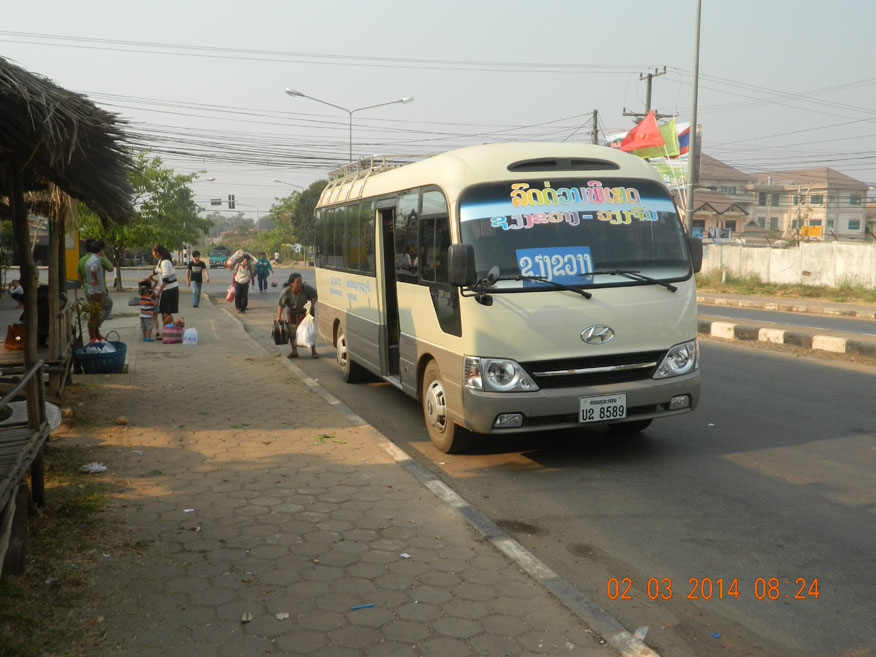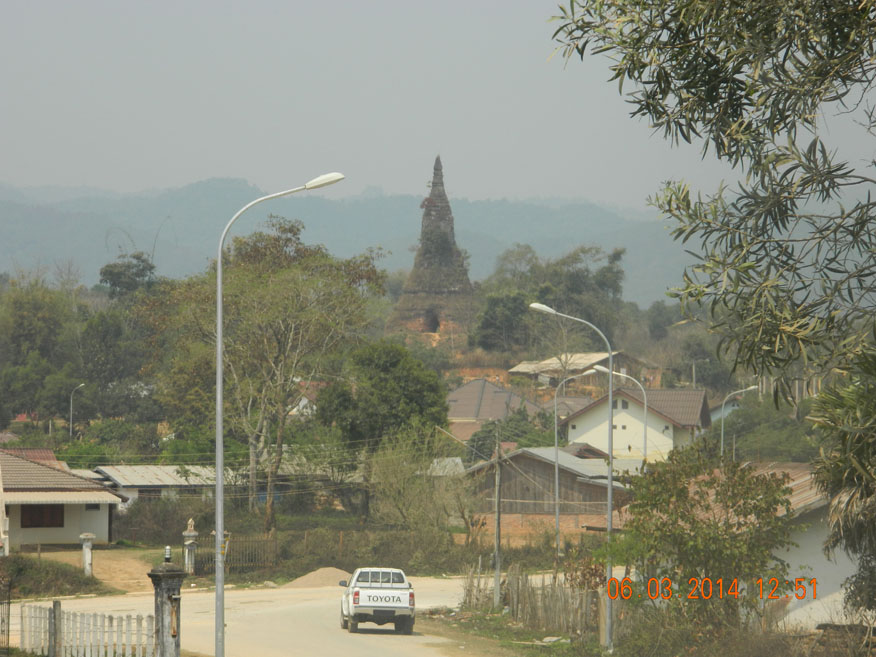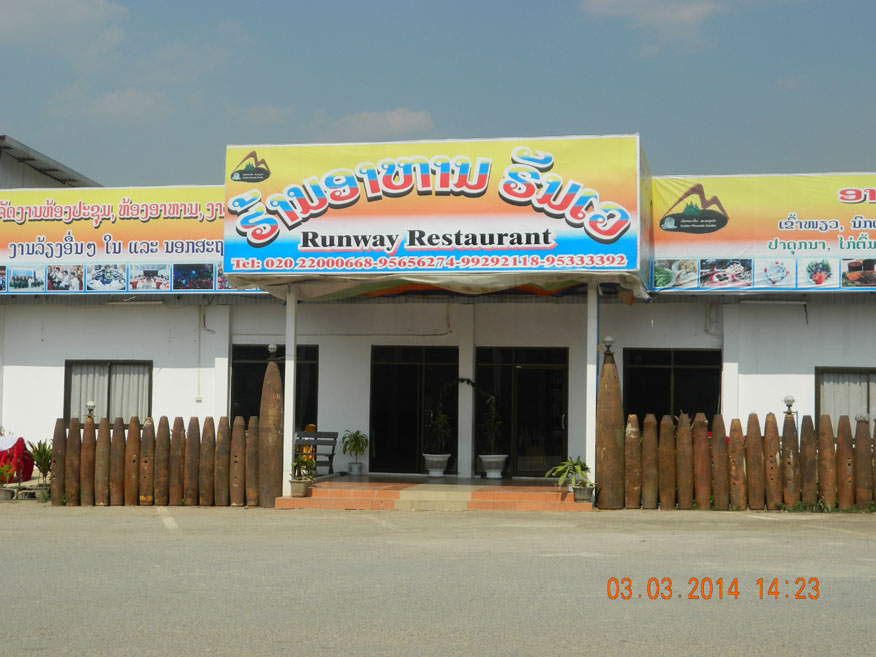
- HOME PAGE
- TOURS LIST
- SITE INDEX
- THIS TOUR SUMMARY
-
TOUR BLOG
DAY 1 - BANGKOK/NAKHON PHANOM/THAKHEK, 25/26 February 2014 DAY 2 - THAKHEK, 27 February 2014 DAY 3 - THAKHEK/PAKSAN, 28 February 2014 DAY 4 - PAKSAN, 1 March 2014 DAY 5 - PAKSAN/PHONSAVAN, 2 March 2014 DAY 6 - PHONSAVAN, 3 March 2014 DAY 7 - PHONSAVAN, 4 March 2014 DAY 8 - PHONSAVAN, 5 March 2014 DAY 9 - PHONSAVAN, 6 March 2014 DAY 10 - PHONSAVAN, 7 March 2014 DAY 11 - PHONSAVAN/VANG VIENG, 8 March 2014 DAY 12 - VANG VIENG, 9 March 2014 DAY 13 - VANG VIENG, 10 March 2014 DAY 14 - VANG VIENG, 11 March 2014 DAY 15 - VANG VIENG, 12 March 2014 DAY 16 - VANG VIENG, 13 March 2014 DAY 17 - VANG VIENG/UDON THANI, 14 March 2014Sunday 2 March 2014
Pakxan departure.....Awaking around 7 am I'm soon ready. I've retained a snack, but the guesthouse has provided me with something anyway. They don't presently have a restaurant. A samlor collects me at 8 pm for the departure point which I assumed would be near the market where I was dropped off earlier, but it's not. I only have a guide time for a bus departure of 9.30 am giving me time to pick up some supplies I will need for the long journey ahead. Well, that plan backfires as I'm deposited on a street corner for which trip I'm charged more. My only provision is my trusty flask of cold water and some snacks. I hadn't a clue how long I need to wait, but thankfully it's not long. Instead of one of those rickety old buses a short-wheel base bus/van turns up, a 24 seater. I climb aboard. My first impression is that this vehicle, while not state of the art, is a big improvement on what I was expecting and has air-conditioning if you can call it that. It's also not full as it departs. However, it picks up passengers just about anywhere it is flagged down. As it heads north out of Pakxan, again I see a fair share of modern structures, indicating relative prosperity in this area, but the road is certainly not good and is not curbed; red dust accompanied by litter is everywhere.
Obscure route.....When I made the decision that Thakhek was to be my first destination in Laos, I looked for a possible route into Xieng Khouang province; the route via Vientiane possibly 2 long days away. When a route was suggested from Pakxan this made things much easier, yet I could not identify a main road linking Pakxan with Xieng Khouang on my maps. It's not long before the van hits the mountains and while the rolling hills around are not at great elevation, there is no simple route through the forested terrain; the Xan River is the obvious route to follow. Soon recent cuttings though the rock appear and with it unpaved roads. The air-conditioning proves insufficient for some passengers who open windows. This is often to dispose of, the disgusting habit in Southeast Asia, litter: The bus company doesn't help by issuing polythene bags, although there is another reason for issue! The windows are promptly closed as clouds of dust get sucked into the vehicle. Progress is reduced to a crawl in places while this passage through Borikhanxai's interior continues for another 50 kilometres. Finally, the bus reaches a T-junction joining a trunk road which opens into a broad valley. From here the road is paved and progress much better.
Enter Xiang Khouang.....As I start to pick up signs to Phonsavan, I calculate that arrival could be around 1 pm, a relatively easy day. Wrong again! At midday, the driver decides to stop for lunch. Of course, he needs a break. This stop lasts about 45 minutes, and I'm told it will take another two hours to reach Xieng Khouang. How could my calculation be so far out? Well there are three reasons. Firstly I hadn't factored in the break. The second is simply one of misinterpretation of place names. In my original planning of this tour I identified the town of Meung Khoun as the old capital of Xiang Khouang province. Phonsavan is the new city; remembering that Mung Khoun was practically destroyed during the Vietnam War. This bus is destined for Xieng Khouang, the provincial name synonymous with Phonsavan which is now the provincial capital. This is good news for me; I had visions of having to change buses. The third reason for my miscalculation is simply geographical. Over the last couple of days I've had no internet connection, so my research is limited. Nevertheless, I do now recall a difficult stretch of road ahead.
Elevated.....After the lunch break the bus follows the river valley and the valley sides begin to close in. The next 30 kilometres will see a steady climb to one of Laos' higher mountain passes. It becomes quite a struggle in places and danger is all too evident. As the road grips the mountain sides it is subject to regular land slips. Two or three have to be negotiated with extreme care. I'm beginning to appreciate what the young bus driver has to go through in the course of his work. As the bus climbs to the summit, hill tribe villages cling to the mountainside much as they do on the Luang Prabang route I described on an earlier tour. The decent down the mountain is less arduous as the valley opens onto a broad plateau and the bus stops to deposit passengers in Mueng Khoun. It's just 30 kilometres now to Phonsavan and the furthest point on this tour.
Phonsavan.....As the bus head towards Phonsavan, totally unfamiliar scenery appears which doesn't consist of lush vegetation so typical of Laos. There are rolling hills totally barren and dry in the heat haze more typical of the plains of the Korat plateau in Thailand but hilly. I arrive at a place of great historic importance and yet my initial impressions are of disappointment. This is no inviting oasis in the desert and in fact it's an almost featureless dusty old town from which a bath and a slug of whiskey seems the only respite. As the bus pulls off the highway and heads into the town of Phonsavan I see no shortage of hotels and guesthouses. The bus parks up opposite a three-star hotel and the few remaining passengers alight and head in its direction. Instinctively I follow, but it proves out of my price range. But other choices are all around.
Dok Khoun Hotel.....I inquire at Dok Khoun Hotel and check out the rooms. Using my check-list I cannot fault this hotel for its facilities. Everything is in place or so it seems. I air on caution and pay for two nights and yet as soon as I complete this transaction there is something strangely odd about this place, something which, I fear, affects this city as a whole. The people here are just so boring it's untrue. They are simple not a proud people, not even interested in keeping their surroundings clean. It's a fact that this area is the most bombed place on earth, something I have to reflect on later but is that a reason for a 'bombed out' spirit? On the subject of bombing this hotel is typical of many hotels and restaurants in the area. I have witnessed the curious array of war relics in bars before, for instance on the Somme but never has so much material been so concentrated in one place as it is here. It's as if a lack of trophies represents some lower status here.
Digging in.....With all these thoughts going through my head, I fail to appreciate that simply getting here is a massive achievement. Few Westerners make it here. Those that do are modern day adventurers the same as me with a high tolerance to the rough and ready. Because of the historical interest in this place I am prepared to make sacrifices. That includes some of the most boring food on earth. I'm soon aware that away from Thai influence in cuisine and into the lap of considerable austere Vietnamese influence I'm going to struggle. I may have to resort to Chinese or Indian influence. I decide to dig in for now and concentrate on the main reason I came to this place in the first place. With an internet connection now intact I will concentrate on the Plain of Jars with at least three important sites located around here.
Next Page.
Bolikhamsai Province
Vientiane to Xiang Khouang Transport, Paksan
Xiangkhouang Province
View towards That Foun Stupa, Meung Khoun

View of Jar Site I with
Typical Scenery around Phonsavan

Ever present War Scrap, Dok Khoun Hotel

Runway Restaurant, Phoukham Resort